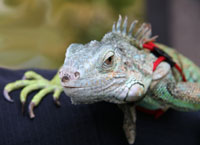By Russ Case
Click image to enlarge Leash harnesses can be a way to get your green iguanas, or other lizards, out into the sunshine. |
After jogging at the beach yesterday, having just finished and gasping for breath while waiting for my head to stop pounding (as is my style), I noticed a woman who was out taking her green iguana for a walk. It was in a harness and meandering through a bunch of ice plant on a hilly slope, the leash extended to maximum length. She told me that as she had been busy all day, and had been out and not even left the television on for him, she felt like her pet “didn’t have much of a day,” so she wanted to take him out for a walk. The iguana, which was a healthy 2 year old, certainly seemed to be enjoying himself, looking alert and interested in things as he roamed about, tongue flicking. A few passersby did double-takes when they noticed what was on the end of the leash the woman was carrying.
I flashed back on my experience with getting a harness on a green iguana. To say it was unsuccessful is an understatement. I thought it would be fun to be able to take my iguana, Yombo, for a walk on occasion, so bought a small leather harness for him, attached to the end of a leash. After some finagling I got his front legs through the holes and attached it according to the manufacturer’s instructions. Yombo sat there for a moment, and then I got to witness some spectacular contortions and twisting, as he frantically tried to escape the harness. He rolled over the ground, getting himself twisted up in the leash, and generally acted as if the harness were made of acid. I got it off him quickly, and thus endeth the Yombo-on-a-leash idea.
This woman’s iguana was not fazed at all, and was very used to his harness. I didn’t ask her if he took to it right off or if there was an adjustment period that featured the twisting and writhing that Yombo had exhibited.
Harnesses can be a way to get your green iguanas, or other lizards, out into the sunshine. Exposure to UVB is a tremendously important consideration when keeping basking lizards, and natural sunlight is terrific to utilize if possible. Outdoor enclosures are another way to facilitate this. If you go this route, be sure shade is available for your pets as well. If nothing else, you can take your lizard outside and let it roam around under your watchful eye. Luckily, there’s life-saving full-spectrum lighting for reptiles that are kept indoors (which are the vast majority, of course). Even if you use full-spectrum lighting for your reptiles, it would still be great if you could get them out into natural sunlight occasionally. For information on artificial and natural light, click here.
Taking your reptiles out for a walk can be a tricky situation. For instance, where I encountered the woman with her iguana, there were many dogs about. I guess she could have scooped up the iguana if a dog-iguana confrontation was imminent, but it seemed a little risky to me, especially given the long length that the leash was extended. She would not have been able to immediately grab her lizard if a dog or something/one else went for it; she would have had to reel the iguana in, and who knows how long that might have taken.
Reptiles that are encountered in public areas are usually regarded as interesting novelties. I’ve never seen anyone react badly when encountering a reptile that is out and about. Still, there are people who are afraid of reptiles, and you want to be careful you don’t cause a ruckus if you’re taking your reptile pets out for a stroll, and this is especially true if your pets are large snakes. I’m all for exposing the public to reptiles and educating people about them, but forcing them on people who may not be comfortable around them is never a good idea.
Acting responsibly goes a long way toward protecting your pets, avoiding possible hassles for yourself and representing reptile owners everywhere in the best possible light.



